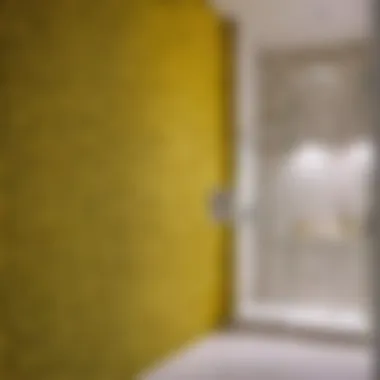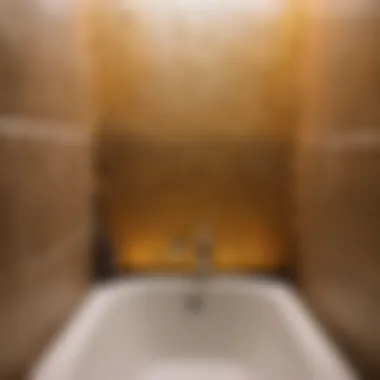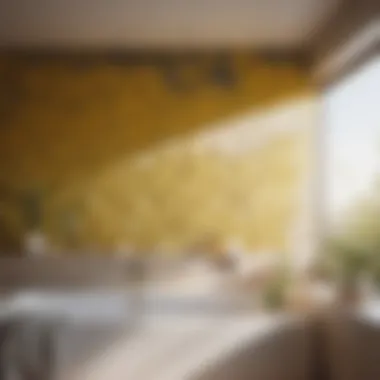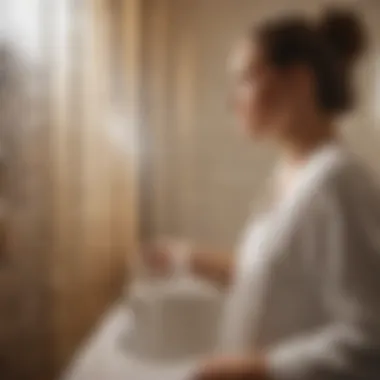Expert Tips for Effective Mold Removal from Bathroom Walls


Materials:
- Protective gear (gloves, mask, goggles)
- Bleach or white vinegar
- Baking soda
- Scrub brush
- Spray bottle
- Water
DIY Steps:
- Prepare the Area: Ensure proper ventilation by opening windows. Put on protective gear to prevent exposure to mold and cleaning agents.
- Mix Cleaning Solution: In a spray bottle, mix one part bleach or vinegar with two parts water. For a natural alternative, mix baking soda with water to form a paste.
- Apply Solution: Spray the cleaning solution onto the mold-infested areas. Let it sit for at least 15 minutes to penetrate the mold.
- Scrub: Using a scrub brush, scrub the mold off the walls. For tougher mold, use a baking soda paste and scrub vigorously.
- Rinse: Wipe down the walls with clean water to remove any leftover cleaning solution and mold residues.
- Dry: Use a clean towel or cloth to thoroughly dry the walls to prevent mold regrowth.
Technical Aspects:
- Tools: Protective gear, scrub brush, spray bottle
- Timing: Allow 15 minutes for the cleaning solution to work effectively
- Techniques: Ensure thorough scrubbing to effectively remove mold
DIY Project Process:
- Sequential Steps: Follow the preparation, cleaning, and drying steps in the prescribed order for optimal results.
- Troubleshooting Tips: If mold persists, repeat the cleaning process or consider seeking professional help for severe infestations.
Understanding Mold in Bathrooms
Understanding mold in bathrooms is vital for maintaining a healthy living environment. Mold growth in bathrooms is a common issue attributed to high moisture levels. By comprehending the underlying causes and health risks associated with mold, individuals can effectively combat this pervasive problem. This article delves into the various types of mold commonly found in bathrooms and elucidates methods for eradicating mold, ensuring a hygienic space for all occupants to enjoy.
Causes of Mold Growth
Moisture accumulation
Moisture accumulation serves as a primary trigger for mold growth in bathrooms. The constant presence of moisture provides an optimal breeding ground for mold spores. Its ability to seep into porous surfaces exacerbates mold proliferation, making it a formidable adversary for homeowners striving to maintain a mold-free bathroom. Despite its stealthy nature, moisture accumulation can be remedied through targeted interventions such as enhancing ventilation systems and reducing humidity levels.
Poor ventilation
Poor ventilation exacerbates mold growth by impeding the airflow necessary to keep surfaces dry. Inadequate ventilation traps humidity, creating a conducive environment for mold colonization. Addressing poor ventilation involves investing in exhaust fans, strategically placing air vents, and ensuring effective air circulation within the bathroom. By improving ventilation, individuals can curtail mold infestation and promote a healthier indoor atmosphere.
Leaking pipes
Leaking pipes present a silent threat to bathroom spaces, fostering mold growth in hidden crevices. The slow drip of water from faulty pipes not only compromises structural integrity but also encourages mold formation. Detecting leaks promptly and repairing damaged pipes are essential steps in averting mold development. Additionally, conducting regular inspections to identify and rectify pipe leaks can safeguard against costly mold remediation in the future.
Health Risks Associated with Mold
Allergies
Mold spores can trigger allergic reactions in individuals sensitive to environmental allergens. Symptoms may include sneezing, nasal congestion, and itchy eyes, posing discomfort and health challenges for affected individuals. Addressing mold-related allergies entails implementing measures to eradicate mold spores and improve indoor air quality, mitigating adverse health effects.
Respiratory issues
Exposure to mold can exacerbate respiratory conditions such as asthma and bronchitis, compromising lung function and respiratory health. Inhalation of mold spores can inflame airways, leading to breathing difficulties and persistent coughing. Minimizing respiratory issues associated with mold necessitates thorough mold remediation and maintenance of optimal indoor air quality.
Skin irritation
Mold exposure may elicit skin irritation symptoms, manifesting as redness, itchiness, and rashes upon contact with mold spores. Individuals with sensitive skin are particularly susceptible to these dermatological reactions, necessitating vigilance in preventing skin exposure to mold-infested surfaces. Implementing stringent cleaning practices and mold removal measures can reduce the occurrence of skin irritation, fostering a healthier living environment.
Types of Mold Commonly Found in Bathrooms
Black mold (Stachybotrys)
Black mold, scientifically known as Stachybotrys, is a toxic mold species characterized by its dark appearance and slimy texture. Its proliferation in damp and humid environments poses serious health risks to occupants. Respiratory issues, allergic reactions, and neurological effects are among the health consequences associated with exposure to black mold. Identifying and eliminating black mold growth is imperative in safeguarding the well-being of individuals and preserving the structural integrity of the bathroom.


Green mold (Aspergillus)
Green mold, commonly referred to as Aspergillus, thrives in moist conditions and presents a common sighting in bathrooms. Despite its non-toxic nature, green mold poses respiratory risks for individuals with compromised immune systems. Preventing green mold infestation involves minimizing moisture levels, enhancing ventilation, and promptly addressing water leaks. Regular cleaning and maintenance practices are essential for controlling the spread of green mold and maintaining a hygienic bathroom environment.
Yellow mold (Aureobasidium)
(TO BE CONTINUED)
Methods for Removing Mold
Mold is a common issue in bathrooms due to high moisture levels, leading to detrimental effects on health and the structural integrity of the space. Understanding effective methods for removing mold is crucial in maintaining a healthy living environment. In this section, we will delve into various approaches to combating mold infestation, including natural remedies, commercial mold cleaners, and preventive measures.
Natural Remedies
When addressing mold growth in bathrooms, natural remedies offer a more eco-friendly and often cost-effective solution. Vinegar, baking soda, and tea tree oil are popular choices known for their mold-fighting properties.
Vinegar
Vinegar, a versatile household product, is highly acidic, making it a potent ally against mold. Its ability to kill mold spores and inhibit their regrowth makes it a preferred choice for environmentally conscious individuals. Despite its strong odor, vinegar's natural composition makes it safe for use in bathroom spaces.
Baking Soda
Baking soda, with its mild abrasive quality, not only helps scrub away mold but also absorbs moisture, creating an unfavorable environment for mold growth. Its versatility in tackling stains and odors makes it a versatile tool in mold remediation.
Tea Tree Oil
Renowned for its antifungal and antibacterial properties, tea tree oil serves as a potent mold deterrent. Its distinct aroma and natural composition make it a favorable choice for those looking to combat mold without harsh chemicals.
Commercial Mold Cleaners
In more severe cases of mold infestations, commercial mold cleaners provide intensive solutions for effective mold removal. These products typically contain potent ingredients designed to eradicate mold efficiently.
Bleach-based Products
Bleach-based cleaners are potent disinfectants that effectively kill mold on hard surfaces. However, their harsh chemical composition may pose health risks and damage surfaces if not used properly.
Ammonia
Ammonia is a powerful cleaner known for its ability to destroy mold and mildew. While effective, it requires careful handling due to its strong fumes and potential to react negatively with other cleaning agents.
Hydrogen Peroxide
Hydrogen peroxide is a gentler alternative to bleach, offering strong antimicrobial properties without harsh fumes. Its bubbling action helps lift mold stains while disinfecting surfaces.
Preventive Measures
Preventing mold growth is as crucial as removing existing mold. Implementing preventive measures can help mitigate future infestations and maintain a mold-free environment.
Improve Ventilation
Proper ventilation is key to controlling humidity levels and reducing mold growth. Installing exhaust fans and ensuring adequate airflow will help dissipate excess moisture, discouraging mold formation.
Use Exhaust Fans


Exhaust fans not only remove excess moisture from the air but also eliminate odors and improve indoor air quality. Regular use of exhaust fans during and after showers can significantly reduce moisture levels in the bathroom.
Repair Leaks Promptly
Addressing leaks promptly is essential in preventing mold growth behind walls and ceilings. Leaks provide the moisture mold needs to thrive; sealing them effectively minimizes the risk of mold infestation.
Hiring Professional Services
When it comes to effectively removing mold from bathroom walls, hiring professional services plays a pivotal role in ensuring a thorough and lasting solution. By enlisting the expertise of professionals, individuals can benefit from a range of specialized knowledge and techniques tailored to combat mold infestations effectively. Professional mold removal services offer a level of proficiency and efficiency that can be challenging to replicate through DIY methods.
Benefits of Professional Mold Removal
Expertise in Mold Identification
Professional mold removal services boast a high level of expertise in mold identification, enabling them to accurately assess the type and extent of mold present in a bathroom. This expertise is crucial in developing targeted removal strategies that address specific mold varieties effectively. By accurately identifying the mold species, professionals can implement the most appropriate removal methods, reducing the risk of incomplete eradication or further mold growth.
Efficient Removal Techniques
One of the key advantages of professional mold removal services is their utilization of efficient removal techniques. These techniques are designed to tackle mold infestations at their root, ensuring thorough cleanup and preventing recurrence. Professionals leverage industry-best practices and cutting-edge equipment to execute mold removal with precision and effectiveness.
Reduced Risk of Mold Recurrence
By engaging professional mold removal services, individuals can significantly reduce the risk of mold recurrence in their bathroom. Professionals not only remove existing mold but also employ preventive measures to inhibit future mold growth. This proactive approach helps to maintain a mold-free environment for an extended period, promoting the overall health and safety of the living space.
Cost Considerations
Factors Influencing Cost
The cost of professional mold removal services can vary based on several factors, including the size of the affected area, the severity of the mold infestation, and the complexity of the removal process. Factors such as the need for specialized equipment, containment procedures, and post-removal inspections can influence the overall cost of the service. Individuals should consider these factors when budgeting for professional mold removal.
Comparing Quotes
When seeking professional mold removal services, it is essential to obtain and compare quotes from multiple providers. Comparing quotes allows individuals to evaluate the cost structures, services offered, and reputation of different service providers. By conducting a thorough comparison, individuals can make an informed decision regarding the most cost-effective and reliable option for their specific mold removal needs.
Value of Professional Service
The value of professional mold removal service extends beyond mere cost considerations. Professional providers offer expertise, efficiency, and peace of mind, ensuring that mold infestations are addressed comprehensively and effectively. While the upfront cost may seem higher than DIY alternatives, the long-term benefits of professional mold removal, including reduced health risks and enhanced property value, make it a worthwhile investment for homeowners seeking a permanent solution to mold problems.
Maintaining a Mold-Free Bathroom
In this article, the importance of maintaining a mold-free bathroom cannot be overstated, especially considering the detrimental effects mold can have on both health and the structural integrity of the house. Mold not only poses health risks but also indicates underlying issues with ventilation and moisture levels. To ensure a healthy living environment, regular maintenance and cleaning practices are crucial. By implementing preventive measures, housewives and homeowners can mitigate the risk of mold growth and maintain a clean and safe bathroom space.
Regular Cleaning Practices
Wiping down surfaces
Wiping down surfaces plays a pivotal role in minimizing mold growth by removing excess moisture and preventing the accumulation of dust and debris, which can serve as a breeding ground for mold. This simple yet effective practice helps maintain cleanliness and hygiene, reducing the likelihood of mold development. Utilizing a mixture of water and mild detergent can aid in thorough cleaning without harsh chemicals that may damage surfaces.
Drying shower walls
Properly drying shower walls post-use is essential for preventing mold growth in the bathroom. Moist environments are conducive to mold proliferation, making it imperative to ensure that shower walls are dried thoroughly after each use. Utilizing a squeegee or towel to remove excess moisture can inhibit mold spores' germination and proliferation, promoting a dry and mold-free environment.
Washing shower curtains


Regularly washing shower curtains is vital in preventing mold and mildew buildup on these surfaces. Shower curtains are prone to accumulating moisture, providing an ideal environment for mold growth. By incorporating a routine cleaning schedule for shower curtains using a gentle detergent or bleach solution, housewives and homeowners can effectively combat mold development and maintain a hygienic bathroom space.
Monitoring Humidity Levels
Using a hygrometer
Hygrometers are invaluable tools for monitoring humidity levels in the bathroom, enabling individuals to assess the moisture content in the air accurately. By regularly checking humidity levels, housewives and homeowners can identify potential issues such as excessive moisture, which could lead to mold growth. Maintaining humidity below 60% is recommended to prevent mold proliferation.
Keeping humidity below %
Controlling humidity levels below 60% is paramount in inhibiting mold growth in the bathroom. High humidity provides an ideal breeding ground for mold spores, making it essential to utilize ventilation systems or dehumidifiers to regulate humidity levels effectively. By implementing measures to reduce moisture in the air, individuals can safeguard their bathroom against mold infestation.
Using dehumidifiers
Dehumidifiers serve as valuable appliances in reducing excess moisture in the air, thereby curtailing mold growth. By extracting moisture from the environment, dehumidifiers help maintain optimal humidity levels, creating an inhospitable environment for mold to thrive. Regularly using a dehumidifier in the bathroom can significantly contribute to mold prevention and ensure a healthy living space free from mold-related issues.
Inspecting for Leaks
Checking under sinks
Inspecting under sinks for any signs of leaks or moisture accumulation is essential in preventing mold from proliferating in hidden areas. Leaks from pipes or faucets can introduce excess moisture, fostering mold growth. By conducting regular checks under sinks and promptly addressing any leaks, housewives and homeowners can mitigate the risk of mold formation and preserve the integrity of their bathroom.
Examining toilet seals
Examining toilet seals for wear and tear is crucial for preventing water seepage and potential mold growth around the toilet area. Damaged seals can lead to leaks and moisture infiltration, creating an environment conducive to mold development. By ensuring that toilet seals are intact and effectively sealing the toilet base, individuals can mitigate the risk of moisture-related issues and maintain a mold-free bathroom.
Inspecting grout lines
Inspecting grout lines between tiles is essential for identifying any signs of mold growth or water damage. Mold can easily accumulate in grout lines due to the porous nature of the material, making regular inspections imperative. By cleaning grout lines regularly and sealing them to prevent moisture intrusion, housewives and homeowners can safeguard their bathroom against mold infestation and maintain a pristine appearance.
Conclusion
Understanding the importance of maintaining mold-free bathroom walls is crucial for ensuring a healthy living environment. Mold infestations pose serious health risks such as allergies, respiratory issues, and skin irritation, making it imperative to address them promptly and effectively. By implementing the methods discussed in this article, individuals can combat mold growth and create a safe space for themselves and their families. The combination of natural remedies, commercial mold cleaners, and preventive measures offers a comprehensive approach to removing mold from bathroom walls and preventing its recurrence. Hiring professional services can provide expertise and efficient removal techniques, further reducing the risk of mold regrowth. Adopting regular cleaning practices, monitoring humidity levels, and inspecting for leaks are key strategies in maintaining a mold-free bathroom.
Summary of Key Points
Impact of mold on health
The impact of mold on health cannot be understated. Mold can trigger allergies, cause respiratory problems, and lead to skin irritation. Understanding the health risks associated with mold is crucial for homeowners looking to create a safe and healthy living environment. By choosing effective removal methods and implementing preventive strategies, individuals can safeguard their well-being against the dangers posed by mold infestations.
Effective removal methods
The selection of suitable removal methods is essential in combating mold effectively. Natural remedies such as vinegar, baking soda, and tea tree oil offer environmentally friendly solutions for mold removal. Commercial mold cleaners like bleach-based products, ammonia, and hydrogen peroxide provide stronger alternatives for more severe mold infestations. Each method has its advantages and disadvantages, requiring homeowners to weigh their options carefully based on the extent of the mold growth.
Preventive strategies
Preventive strategies play a crucial role in mold prevention. Improving ventilation, using exhaust fans, and repairing leaks promptly are proactive measures that can inhibit mold growth. By maintaining a dry and well-ventilated bathroom, individuals can create an environment that is less conducive to mold development. Investing in preventive strategies not only reduces the likelihood of mold recurrence but also promotes overall indoor air quality and health.
Final Thoughts
Importance of timely mold removal
Timely mold removal is essential in mitigating health risks associated with mold exposure. By addressing mold growth promptly, individuals can prevent further health complications and maintain a safe living space. Ignoring mold issues can exacerbate respiratory problems and allergies, emphasizing the importance of timely intervention.
Maintenance for long-term mold prevention
Regular maintenance is key to long-term mold prevention. By adopting consistent cleaning practices, monitoring humidity levels, and inspecting for leaks, individuals can proactively prevent mold infestations. Creating a routine for mold prevention helps in identifying issues early and implementing corrective measures promptly. Ensuring a healthy bathroom environment requires ongoing maintenance and proactive measures to combat mold growth effectively.
Creating a healthy bathroom environment
Creating a healthy bathroom environment is essential for overall well-being. By cultivating a space that is clean, well-ventilated, and moisture-controlled, individuals can enjoy a mold-free environment. Emphasizing cleanliness, proper ventilation, and timely repairs contributes to a healthier living space and reduces the risk of mold infestations. Prioritizing a healthy bathroom environment promotes a sense of well-being and enhances the overall quality of life.







